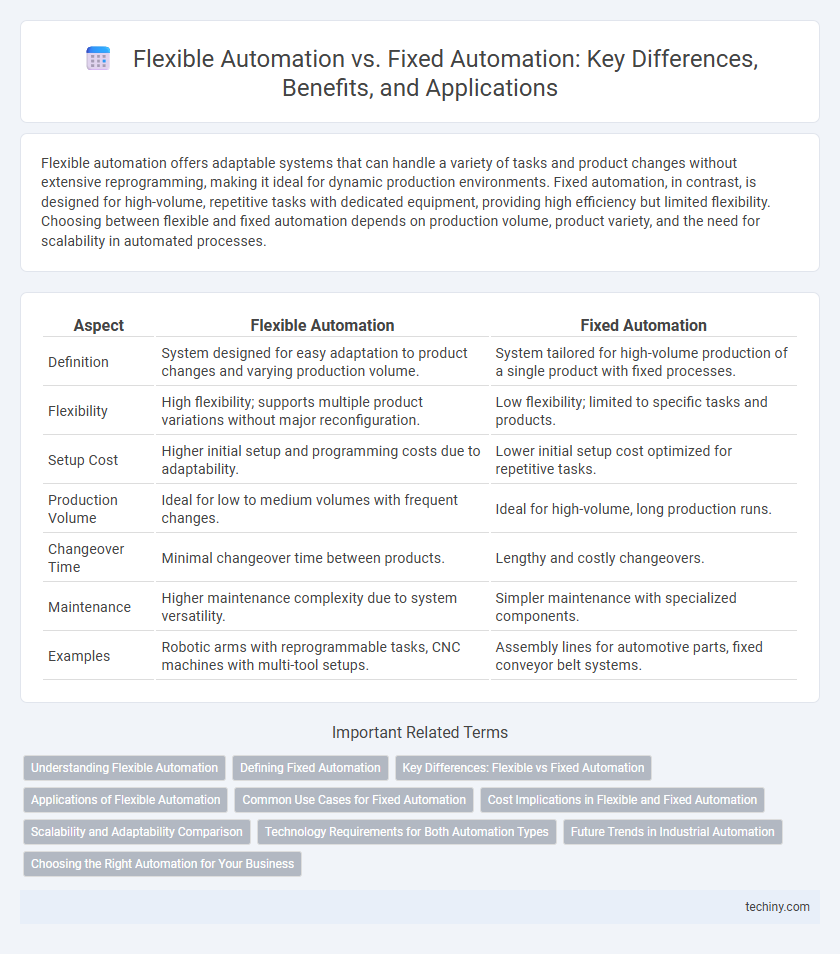Flexible automation offers adaptable systems that can handle a variety of tasks and product changes without extensive reprogramming, making it ideal for dynamic production environments. Fixed automation, in contrast, is designed for high-volume, repetitive tasks with dedicated equipment, providing high efficiency but limited flexibility. Choosing between flexible and fixed automation depends on production volume, product variety, and the need for scalability in automated processes.
Table of Comparison
| Aspect | Flexible Automation | Fixed Automation |
|---|---|---|
| Definition | System designed for easy adaptation to product changes and varying production volume. | System tailored for high-volume production of a single product with fixed processes. |
| Flexibility | High flexibility; supports multiple product variations without major reconfiguration. | Low flexibility; limited to specific tasks and products. |
| Setup Cost | Higher initial setup and programming costs due to adaptability. | Lower initial setup cost optimized for repetitive tasks. |
| Production Volume | Ideal for low to medium volumes with frequent changes. | Ideal for high-volume, long production runs. |
| Changeover Time | Minimal changeover time between products. | Lengthy and costly changeovers. |
| Maintenance | Higher maintenance complexity due to system versatility. | Simpler maintenance with specialized components. |
| Examples | Robotic arms with reprogrammable tasks, CNC machines with multi-tool setups. | Assembly lines for automotive parts, fixed conveyor belt systems. |
Understanding Flexible Automation
Flexible automation integrates programmable machinery that adapts quickly to product changes and varying production volumes, enhancing efficiency in dynamic manufacturing environments. Unlike fixed automation, which is designed for high-volume, repetitive tasks with minimal variation, flexible automation supports multiple product types without extensive reconfiguration. This adaptability significantly reduces downtime and increases production versatility, making it ideal for industries requiring rapid customization and diverse output.
Defining Fixed Automation
Fixed automation, also known as hard automation, involves using specialized equipment designed for high-volume production with minimal variation. It features dedicated machinery and processes configured for repetitive tasks, ensuring consistent output and low unit costs. This type of automation is ideal for stable product designs and long production runs where flexibility is not required.
Key Differences: Flexible vs Fixed Automation
Flexible automation allows rapid reconfiguration for various product types, making it ideal for customized production and smaller batch sizes. Fixed automation is designed for high-volume, repetitive tasks with minimal variation, offering greater efficiency and lower unit costs. Key differences include adaptability, cost efficiency, and production volume suitability, with flexible automation emphasizing versatility and fixed automation prioritizing consistency.
Applications of Flexible Automation
Flexible automation excels in manufacturing environments requiring frequent product changes and customization, such as electronics assembly and automotive production. It adapts to varying product designs without extensive reprogramming, increasing efficiency in batch production and mass customization scenarios. Industries leveraging flexible automation benefit from reduced downtime and enhanced responsiveness to market demand.
Common Use Cases for Fixed Automation
Fixed automation is commonly used in high-volume production environments such as automotive assembly lines, where repetitive tasks like welding, painting, and component installation require consistent precision and speed. It excels in manufacturing standardized products with minimal variation, ensuring cost efficiency through dedicated equipment and tooling. Industries like electronics, packaging, and consumer goods also utilize fixed automation for processes that benefit from repetitive, uniform operations.
Cost Implications in Flexible and Fixed Automation
Flexible automation incurs higher initial investment due to advanced programmable systems and software integration, but offers cost savings through adaptability to multiple product types and reduced downtime. Fixed automation requires lower upfront costs with specialized machinery optimized for high-volume, repetitive tasks, resulting in decreased unit costs but limited flexibility and higher long-term expenses when product changes occur. Evaluating cost implications demands considering production volume, product variation, and the lifecycle expenses associated with system modifications.
Scalability and Adaptability Comparison
Flexible automation offers superior scalability by easily accommodating changes in product design and production volume, enabling rapid shifts without extensive reconfiguration. Fixed automation, while cost-efficient for high-volume, repetitive tasks, lacks adaptability and struggles to scale for varied or customized products. The inherent flexibility of programmable systems in flexible automation supports dynamic manufacturing environments, making it ideal for industries requiring frequent product updates and diverse output.
Technology Requirements for Both Automation Types
Flexible automation requires advanced programmable control systems, modular hardware, and sophisticated software capable of rapid reconfiguration to handle varying tasks and product types. Fixed automation depends on specialized, rigid machinery designed for high-volume production of a single product, emphasizing mechanical precision and minimal software complexity. Both technologies demand robust sensors and actuators, but flexible automation prioritizes adaptability in control architecture, while fixed automation focuses on optimizing speed and repeatability.
Future Trends in Industrial Automation
Flexible automation systems integrate advanced robotics and AI to enable rapid reconfiguration for diverse production tasks, addressing increasing demands for customization and agility in manufacturing. Fixed automation remains cost-effective for high-volume, repetitive processes but struggles to adapt to dynamic market needs. Future trends emphasize hybrid solutions combining flexibility and efficiency with real-time data analytics and IoT connectivity to optimize industrial automation performance.
Choosing the Right Automation for Your Business
Choosing the right automation for your business requires understanding the key differences between flexible automation and fixed automation. Flexible automation offers versatility by accommodating various product types and design changes, ideal for businesses with dynamic production needs, whereas fixed automation provides high efficiency and cost-effectiveness for high-volume, repetitive tasks with minimal variation. Evaluating factors such as production volume, product variety, and change frequency helps determine the most suitable automation approach to maximize operational efficiency and return on investment.
Flexible Automation vs Fixed Automation Infographic

 techiny.com
techiny.com